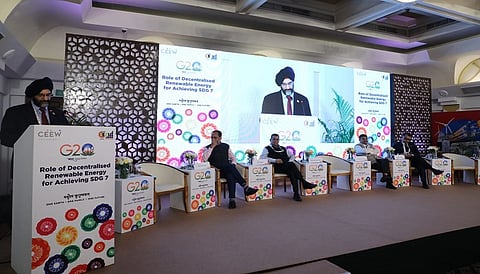
- News Updates
- PSU Watch
- Defence News
- Policy Watch
- हिन्दी न्यूज़
- Jobs Watch
- States News
- Event News

New Delhi: India plans to have 50 percent of installed capacity of power from non-fossil based energy sources by 2030, a top official of the Union Ministry of New and Renewable Energy said on Thursday.
Bhupinder Singh Bhalla, Secretary of the Union Ministry of New and Renewable energy, was addressing a side-event of the fourth Energy Transition Working Group meeting held in Goa during the day.
He said although a wide variety of renewable technologies are available, each with their unique advantages, solar energy, in particular, has emerged as the technology of choice that can play a key role in driving energy access, security and transition.
The challenge to provide 'Universal Energy Access' cuts across other global energy transition issues and, hence, there was need to make rapid strides towards providing reliable, sustainable and affordable energy access to all or else progress in others areas would get hampered, he said.
"India has made ambitious commitments as part of our transition towards clean energy. We are planning to achieve 50 percent cumulative electric power installed capacity from non-fossil fuel-based energy resources by 2030," he said.
"Through the report on 'Roadmap of Solar Energy for Universal Energy Access', developed under India's G20 Presidency in 2023, India aims to showcase how solar energy, in its various configurations, can play a key role in achieving electricity access and in providing socio-economic benefits in countries around the world," he added.
Speaking on the occasion, Goa chief secretary Puneet Kumar Goel said the use of diesel generators, particularly in remote regions or islands, results in a significantly high cost of electricity of up to Rs 36 per unit.
This is because high transportation costs were pushing up fuel rates, Goel said, adding that solar energy was able to provide electricity to such regions even during natural disasters.
Goel said India has set ambitious targets for decentralised solar, and their deployment can be supported through the use of feed-in tariffs and tariff restructuring for grid connected decentralised solar capacity.
"Additionally, battery costs are expected to come down with large scale procurement, further supporting the development of solar mini-grids. Such mini-grids can also see improved reliability and reduced power equipment costs through hybridisation of solar with wind or biomass energy," Goel contended.
Goel said the equipment manufacturing at scale, alongside capacity for on-ground execution and operations and maintenance, remain bottlenecks that must be addressed.
(PSU Watch– India's Business News centre that places the spotlight on PSUs, Bureaucracy, Business, Defence and Public Policy is now on Google News. Click here to follow. Also, join PSU Watch Channel in your Telegram. You may also follow us on Twitter here and stay updated.)
